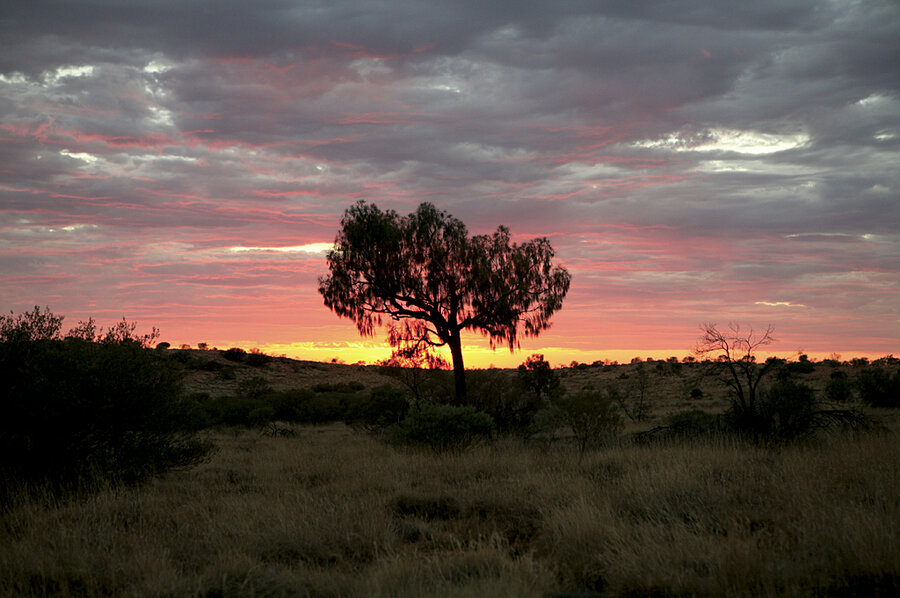Outback odyssey
Loading...
I was starting to feel just a bit frantic.
As a reporter for this newspaper on assignment in Australia's vast Red Center, I was speeding toward the second of several stories about Aboriginal life. The wide red dirt road I was traveling in a rented four-wheel drive vehicle had no signs and lots of mysterious forks. I was late for an interview – and felt completely lost. I had no cellphone, no GPS.
The Australian government in the early 1990s was handing back tracts of land to Aboriginal family groups who could prove an ongoing link to their land. I was headed to interview an Aboriginal couple who were part of an extended family group that had gotten their land back and were giving tours to white people (or Europeans, as they called us).
After driving for several hours, I finally saw a couple of houses and a girl lying on a hammock outside. Her complicated set of directions took me to the top of a hill. A man came running toward the car, waving his arms. "Can't come here. Men's land! Women's land over there." He drew me a map in the dirt.
I got back in the car and, OK, I'll admit it, I started to cry. It wasn't just about being late. Normally, I was organized and prepared, but this whole trip had been filled with unusual setbacks, bad decisions, forgotten items.
Still, I had a job to do and I pulled myself together. I finally found Mavis, the woman I was scheduled to meet. But she had started the tour early to have more time for me, and was too deep into it to stop.
"Don't panic," she said. That's interesting, I thought. I had dried my tears and put on my competent-reporter face. But maybe she saw something I was trying to mask.
"You wait over there," she told me, pointing to a thatched shelter in the middle of wide-open land. "I'll be about an hour."
That was fine. Next to the shelter was a Coke machine. It looked odd sitting there in the middle of this peaceful valley, but it dispensed a cold Coke with the familiar clunk. Unlike the endless red desert I'd just driven through, this was a watered place, with vegetation.
I sat on the table, drinking my Coke and looking out over the valley. It was completely silent. Birds flew overhead. The ever-present flies buzzed around.
Gradually, my breathing slowed, my heart steadied. I had all this time and began to think about my life. About a deep disappointment I'd lugged with me to Australia to sort out, but had avoided doing so. About how sped-up I was most of the time as a reporter – and in life. And why was that? Was that getting me anywhere? Was that a way to live?
Mavis returned. "It's my lunch time now," she said. "I'll see you in an hour and we'll do the tour." In my city life, I would have been annoyed at being kept waiting yet a second hour. But by that point, another hour in what now seemed like the best place in the world was just fine. I was eager to think some more. Normally I'd fill an "empty" chunk of time like this by reading, but a book was one of those things I'd forgotten. I wondered what that said about my using books to shield me from deep thought?
When Mavis came back this time, we had a lovely tour. She pointed out an indentation in stone where women went to have their babies; the plants they used for a variety of purposes. She talked about how she and her husband were slowing down and wanted the grandchildren to take over the tours. But the young ones were shy and resisted. So the couple continued. The big tour operators had discovered them and wanted to bring groups every day. Mavis was clear that she didn't want such an intense, fixed schedule. They needed time for sacred family business. The tour leaders, she said firmly, would "just have to be patient."
And so would I, I decided. That night, on their land, I camped out alone under the wide Australian sky. I felt changed in some deep way, and wondered if it would last.
It did, for a while. Australians take their leisure time more seriously than do Americans. But I soon returned to the United States, where life once again became tense, hectic, with too little time for deep thought. Or so I believed. The experience had provided me with something I hadn't given myself: a window for taking stock; a time to sort out the sharp, unresolved pieces of my life and to ponder them.
But just because I hadn't given myself that before didn't mean I couldn't. Ultimately, that quiet time did bear fruit. I spent the next few years deeply searching whether I could – or should – adopt a child as an older single parent. Despite wide pendulum swings of indecision, the desire to be a parent and to take this next step was quiet and strong – and ultimately prevailed. I adopted a 7-year-old girl in 2003. Once I made that major life decision, others fell into place, too. I left daily deadlines and the frenetic East Coast for life as a writer and editor in a small Oregon town.
It's funny that it took lessons learned from Australia's Red Center to get me to seek out, as a friend put it: "More green. Less noise."





